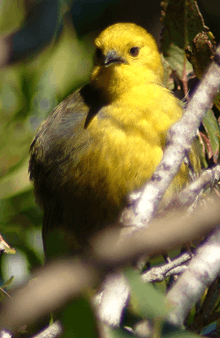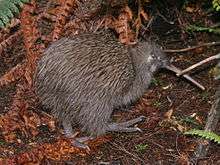Yellowhead (bird)
| Yellowhead | |
|---|---|
 | |
| Yellowhead or mohua | |
| Scientific classification | |
| Kingdom: | Animalia |
| Phylum: | Chordata |
| Class: | Aves |
| Order: | Passeriformes |
| Family: | Mohouidae |
| Genus: | Mohoua |
| Species: | M. ochrocephala |
| Binomial name | |
| Mohoua ochrocephala (Gmelin, 1789) | |
The yellowhead or mōhua (Mohoua ochrocephala) is a small insectivorous, passerine bird endemic to the South Island of New Zealand. Recent classification places this species and its close relative, the Whitehead, in the family Mohouidae.
The yellowhead and the whitehead have allopatric distributions as, conversely, the latter is found only on the North Island and several small islands surrounding it. Although abundant in the 19th century, particularly in beech forests from Nelson and the Marlborough Sounds to Southland and Stewart Island/Rakiura, they declined dramatically in the early 20th century due to the introduction of black rats and mustelids. Today they have vanished from nearly 75% of their former range. A quarter of the mohua population now lives in the beech forests of the Catlins area.
Conservation
In New Zealand, mohua have the status of a protected threatened endemic species. Conservation efforts are being made to ensure its survival and mohua populations have been established on several predator-free offshore islands, such as Breaksea Island in Fiordland and Ulva Island.
Pest control efforts by the Department of Conservation, have managed to stabilise some mainland mohua populations. For example, where biodegradable 1080 poison was used to control rats in the Dart valley, there was a more than 80 per cent survival rate, compared with just 10 per cent in un-treated areas.[2] The population of mohua in the Landsborough valley has increased four-fold since 1998, thanks to an intensive programme of pest control, including aerial 1080. The population is now strong enough for birds to be transferred out to establish a new population on Resolution Island.[3] Similar aerial 1080 operations in the Catlins [4] and the Hurunui,[5] Hawdon and Eglinton valleys[6] have had equally encouraging results. DOC and TBfree New Zealand accounted in March 2014 a significant repopulation in the Catlins of other avian species, including bellbird and tomtit due to the reduction in predators.[7]
Popular culture
The yellowhead appears on the reverse side of the New Zealand $100 note.
References
- ↑ BirdLife International (2012). "Mohoua ochrocephala". IUCN Red List of Threatened Species. Version 2013.2. International Union for Conservation of Nature. Retrieved 26 November 2013.
- ↑ Department of Conservation: Making mohua safe at Lake Wakitipu
- ↑ Hokitika Guardian, 22 August 2011
- ↑ TVNZ: 1080 poison pays off for endangered NZ bird
- ↑ Department of Conservation
- ↑ 1080: The Facts: 1080 helping mohua
- ↑ Department of Conservation http://doc.govt.nz/about-doc/news/media-releases/2014/catlins-mohua-increase-after-pest-control/ 07 March 2014
External links
- BirdLife Species Factsheet
- Mohua factfile - Department of Conservation website
- Operation Ark
- Information about the use of 1080 poison for pest control in New Zealand
- Saving mohua in Westland (video) - Department of Conservation
- The Last Mohua - Forest and Bird feature
- 1080 and mouhua - information for Maori Tai Raukawa website
- Declines in common, widespread native birds in a mature temperate forest Graeme P. Elliott A., Peter R. Wilson B., Rowley H. Taylor B., Jacqueline R. Beggs C.
- Heather, Barrie D; Robertson, Hugh A & Onley, Derek (2000). The field guide to the birds of New Zealand. Viking: Printing Press. ISBN 0-670-89370-6.
- "Department of Conservation: Mohua (Yellowhead)". Mohua (Yellowhead). Retrieved July 2007. Check date values in:
|access-date=(help)

